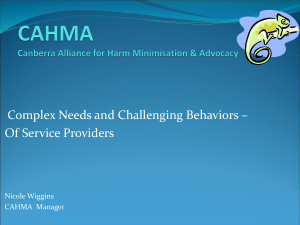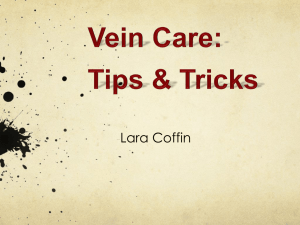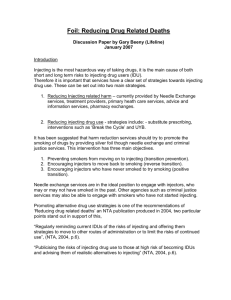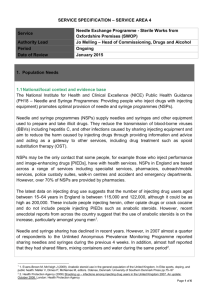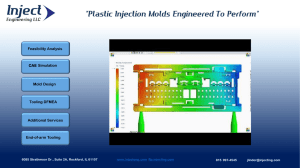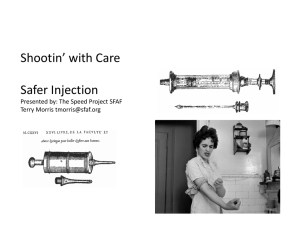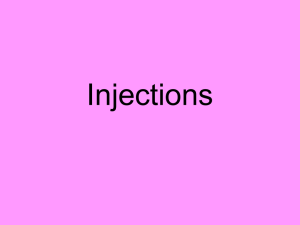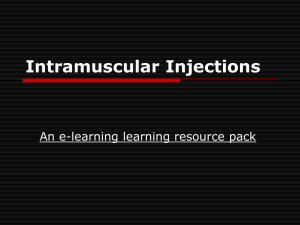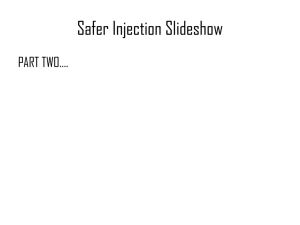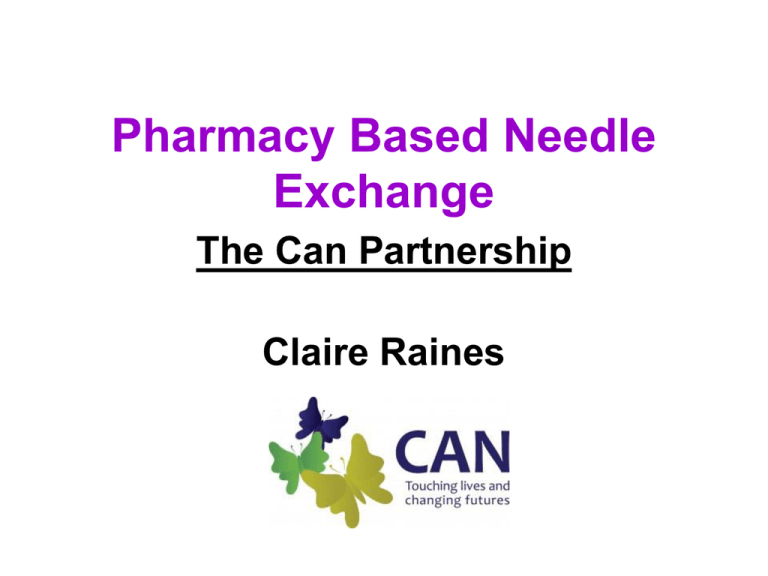
Pharmacy Based Needle
Exchange
The Can Partnership
Claire Raines
Introductions & brief overview of
training plan
•
•
•
•
•
•
Who we are
Length
Break
House-keeping
Can Partnership
Referrals/Open
Access
Aims & Objectives
Pharmacy
Individual IDU
Community
Can
Partnership
• Promotion of the value of a
PBNX to the local
community and to the
individual.
• Enhance awareness of
who may use the PBNX
• To give insight into why NX
exists
• To show how you can
follow best practice (to run
an PBNX with excellence!)
Feelings / expectations / attitudes
Staff
• Shoplifting
• Fear
• Mistrust
• Lack Of Confidence
• Personal Feelings
(disgust/distaste)
NX Customer
• Social Embarasment
/Stigma
• Fear
• Questions/Fear of
• Low expectations of
staff knowledge
Taking a walk in their shoes
exercise
• 2 volunteers required!
In their shoes…
• Mirrored expectations.
• IDUs research shows that heroin users have a more acute ability to
spot signs of fear/disgust/anger in a persons facial expressions.
• Also that they are very bad at recognising happiness/love/affection.
This is thought to be due to expectation of these expressions in
family and loved ones.
• As a result it’s incredibly important for pharmacy staff to be
more aware of their manner when dealing with substance
users.
• Being more aware of how the transaction may feel for the IDU will
also mean they feel less stigmatised, this is also when it is important
that the transaction doesn’t happen on the shop floor but in a
consultation room.
Desired expectations / attitudes
Staff
• Respect/polite
• Positive / friendly
• Open
• Confident
• Confidential /
Boundaried
• Knowledgable
PBNX Customer
• Respectful/Polite
• Friendly
• Clear
• Confidence in staff
• Open / understanding
• Knows boundaries
• Willing to accept
advice.
WHY?, WHY? & WHY?
Why your pharmacy might offer
PBNX ?
• You are able to advise on a range of issues
including the prevention of drug-related death,
overdose prevention, blood-borne infections,
oral health, sexual health, contraception and
safer sex, nutrition, minor infections, wound
dressings, dental health and nicotine
replacement therapy.
• Opening hours
• Alternative option
• Location
Why are you providing this service
anyway?
• You will become one of the ‘gateways’ in bringing people
who inject drugs into contact with a range of community
services.
• To assist the person to remain healthy until they are
ready and willing to cease injecting and ultimately
achieve recovery .
• encouraging people to remain healthy with self-care or to
address their other health needs.
• To protect health and reduce drug related deaths.
• To reduce sharing /risky behaviours by providing sterile
injecting equipment, advice and information.
• To promote safer injecting practices by providing and reinforcing
harm reduction messages - including safe sex advice and advice on
overdose prevention (e.g. risks of poly-drug use and alcohol use).
• To improve the health of local communities by preventing the spread
of blood-borne infections by ensuring the safe disposal of used
injecting equipment.
• To maximise the access to help of all injectors, especially the
socially excluded.
• To help people access other health and social care eg: CAN
Partnership / The Terrance Higgins Trust/ AA / The Kings Arms
Project.
• To join close working relationships with other local community
services.
& if you’re still not convinced…
“The cost of providing health services to
someone who injects drugs is estimated to
be about £35,000 over their lifetime. The
related costs of crime are estimated to be
an additional £445,000 over a lifetime.”
- NICE.ORG.UK
Why inject?
• Substance misuse
(Lifestyle,boredom,socialising,
experimental,addiction,needle
fixation,tolerance levels,coping
mechanism,other abuse past or present)
• PIEDS (confidence/status,lifestyle,other
abuse past or present, self-image/peer
pressure/competition/mental health)
Target PBNX population
• PBNX’s aim to help people over the age of 18 who inject
illicit substances. This includes opioids (eg; heroin) and
stimulants (eg; amphetamines or cocaine) either
separately or in combination (eg; speed-balling) and also
adults who inject non-prescribed anabolic steroids and
other performance and image-enhancing drugs (PIEDs).
These customers can
include…
• High volumes
• In a hurry to be served
/withdrawing/intoxicated
• Sex Workers
• Homeless
• Dual diagnosis
• Clients of services that prescribe
• All of the above
1ml RED (A) pack £2.81
• 10 x 1ml combined
needle & syringe
• 10 x cooking spoons
• 10 x citric acid sachets
• 10 x alcohol swabs
• 1 x 0.25litre bin
For I.V use / injecting
into surface veins.
Suitable for
opiate/amphetamine
use.
2ml Green (B) pack £2.75
• 10 x 2ml barrel
• 10 x Blue 1 ¼” needles
• 10 x Green 1 ½”needles*
FOR DRAWING UP
• 10 x Cooking spoons
• 10 x Citric Acid sachets
• 10 x Alcohol Swabs
• 1 x 0.45litre bin
For injecting into deeper
veins (femoral/ groin
veins).
For I.M injecting.
1ml Brown ( C ) pack £2.83
• 10 x 1ml combined
needle & syringe
• 10 x Cooking spoons
• 10 x Vit C sachets
• 10 x Alcohol swabs
• 1 x 0.25litre bin
For injecting into surface
veins, I.V injecting.
Alternative to Red Pack
(A) : Vit C instead of
Citric Acid
5ml Yellow (D) pack £1.84
•
•
•
•
10 x 5ml barrels
10 x alcohol swabs
10 x blue 1¼” needles
10 x green
1½”needles *FOR DRAWING UP
• 1 0.45 litre bin
For injecting into
deeper veins, I.M
injecting. Suitable
for steroid injectors.
Pharmacy Needle and Syringe Provision operating
policies & procedures might include:
• Client dignity, privacy, confidentiality and data
protection
• Sharps safety
• Needle Stick Injury / Body spill proceedure
• Individual Syringe Identification
• Return of used injecting equipment
• Provision for Young People
• Client complaints procedure
• Signposting
Why do injectors prefer this
method?
• Different drugs can be introduced into the body
in several ways.
• Drugs can be snorted, smoked, swallowed,
taken rectally, or injected. Each of these
processes has the same ultimate purpose – to
get the blood into the bloodstream, and to reach
the brain!.
• Injection has the optimum“Bioavailability” –It is
the quickest way and bypasses most barriers to
get to the CNS.
What is injected?
•
•
•
•
•
•
•
•
Heroin
Amphetamines
Crack
Heroin and crack
Methadone Amps / Sugar Free mixture
Crushed Pills
Steroids
Malanatan/Malanotan 1 and 2
(1=tanning;2=tanning/sexual
disfunfunction)stimulates the pigment cells in
your body to produce more melanin
,unregulated,from inside out change in skin tone.
Intravenous injection
(I.V)
• Intravenous injecting is a highly efficient way of
introducing drugs into the body.
• When drugs are injected - the filtering and
delaying mechanisms that protect us when
things are absorbed via the gastro-intestinal
tract, lungs or skin - are bypassed.
• The potential for infection and overdose are
increased.
Intramuscular Injecting
(I.M)
Discuss as a group!
Subcutaneous Injecting
(S.C)
• Provide handouts
• Discuss as a group
Briefly, how do drugs enter and exit
our body?.
• If drugs are swallowed, the drug is absorbed into the
bloodstream through the stomach and the digestive tract.
• This process can take a considerable time, an hour or
longer.
• As mentioned, injecting has the fastest introduction rate
of the ways (UTB/Swallowed/Snorted/Oral/Smoked).
• Once in the blood stream, the blood from the stomach
and the intestines passes through the liver before
reaching the heart.
• The liver removes toxins from the blood stream, and part
of this process includes breaking down substances such
as drugs.
• Each subsequent pass round the body and through the
liver removes more of the drug from circulation.
Arteries & Veins
•
•
•
•
Arteries take oxygenated blood from the lungs to the
rest of the body They branch out, diminishing in size,
until they reach the capillaries.
The blood passes through the capillaries in the
tissues, releases its oxygen, and is collected again in
small veins , which by joining together progressively
increase in size.
The arteries return de-oxygenated blood back to the
lungs via the heart. All drugs injected into veins must
follow a route back through veins of increasing size to
the heart.
From the heart the drugs are pumped the short
distance to the lungs where the blood passes through
the capillaries of the lungs to be re-oxygenated, and
then they return to the heart to be pumped to the
brain.
•
(The exception to this description is the pulmonary
artery, it carries de-oxygenated blood from the heart
to the lungs. All other arteries carry oxygenated blood.
The pulmonary vein is unique because it carries
oxygenated blood from the lungs to the heart.)
•
Valves are only found in veins, they assist the flow of
blood back to the heart by preventing back flow.
The basic theory behind needle
sizes
“Needle Gauge”
• Needles are measured in terms of their Length,
and their Gauge.
• Length may be given in millimetres (mm) or in
imperial measures.
• The size of a needle is also measured by the
external diameter of the needle, which is called
the Gauge (G or GA).
• The hubs of needles are also colour coded, and
shorthand for different gauges.This colourcoding only refers to gauge not length.
What happens after
injecting?
• When a drug is injected into a vein, it reaches the brain
via the lungs in a matter of seconds.
• The drug is not significantly diluted: hence the
experience of the 'rush' or 'hit' as the brain becomes
rapidly intoxicated.
• The fact that all venous blood must pass through
capillaries in the lungs before going to the arteries
means that solid matter and air bubbles that are injected
into veins cannot reach the brain (except in exceedingly
rare circumstances it is only possible if someone has a
hole between the chambers of the heart); they will
instead get trapped in the capillaries of the lungs.
Intravenous injection
•
•
•
1.
2.
3.
4.
5.
Generally, the arms are the least risky
place to access veins for injecting. The
main aim of advice given to injectors,
(after prevention of spread of blood-borne
viruses) should be to maximise the length
of time they are able to use the veins in
their arms.
When the arm veins can no longer be
used, injectors should consider, and
workers should promote, switching to a
non-injecting route of drug use.
Irreversible damage to the veins can
occur where there is:
Repeated use of the same injecting site
Poor technique
Injection with blunt needles
Injection with needles that are too large
Injection of irritant substances.
Steroid users & Injecting
But what are PIEDS / “Steroids”?
Injecting Steroids
• A large proportion of the products on the market are lowquality fakes, containing little or no active ingredients.
• Standards of production are highly variable, and
products are liable to be manufactured in non-sterile
• environments.
• Products are available in oral preparations, single dose
ampoules and multi-dose bottles.
• Solutions for injection are intended to be injected
intramuscularly, and often oil-based,resulting in a thicker
solution than water based preparations.
Things for injectors to remember
Basic advice that will help to keep
veins and skin healthy include:
•
•
•
•
•
•
Wash hands before and after ,clean sites before with a swab, apply pressure after.
Keep personal equipment in a defined, clean area.
Use sterile equipment only, once only, do not reuse
Do not share
Dispose of items safely
Introduce, inject and remove needles gently and slowly at a shallow angle towards the
heart.
•
Alternate injection sites, allowing veins to rest and recover -Smoke rather than injecting
at times in order to rest veins
•
Become ambidextrous so that they can inject in both arms it is best to encourage this
before the onset of any problems, as it is much easier to practise new techniques when
relaxed and the outcome is not crucial
•
Discourage use of tourniquets, release them prior to injecting
•
Stay away from sites that have become infected , get medical help.
•
Do not flush /back-load/front-load
•
Do not inject where you feel a pulse or if the blood is bright red.
Just how dangerous injecting will be on any one occasion is affected by:
The understanding the injector has of their underlying structures
The dexterity of the injector
The state of mind of the injector (e.g. intoxicated or not)
The substance being injected
Luck.
Discretion
• When handing over the
exchange materials,
consider using a suitable
bag, typically an opaque
dispensing bag
• This opportunity can be
taken for health-promotion
activities/leaflets/flyers &
advice booklets.
Sharps/ Needle-stick Injuries
1.
2.
3.
4.
5.
Clean it
Report it
Call for help
Get treated
ID source / needle
/patient if possible.
Percutaneous injury (e.g. needle, instruments, bone fragments, significant bites which break the skin, etc)
Exposure of broken skin (abrasions, cuts, eczema, etc)
Exposure of mucous membranes including the eye
•Gently Squeeze Wound
•Place wound/mucous membrane (eye) under flow of TEPID water,
•DO NOT Scrub,
• DO NOT swallow the water.
Within 1 HOUR Go directly to A&E, South Wing Hospital,
Tell A&E staff what has happened and that you must be seen within the hour of injury
If taking the needle this must be picked up with a tool for litter picking,
placed inside a sealed hard container safely (sharps bin)
Best Practice - Pharmacy-based needle exchange
operation
Be aware of policies & protocols for :
• Young people
• The Intoxicated
• Psychological instability
• Body spills
• Staff Hep B vaccinations
• Client confidentiality - including what to do when a
patient requests needle exchange who is also being
prescribed substitute medication.
Dealing with unacceptable behaviour / guidance on:
– what constitutes unacceptable behaviour
– ways of minimising unacceptable behaviour.
Working with Young Service Users
Adult models of Needle Exchanges are not appropriate for
young people (a person under the age of 18).
• It is therefore recommended that Pharmacy Needle
Exchanges do not provide this service to those under,
or who appear to be under 18 years of age.
• The course of action to a young person presenting to a
Pharmacy Needle Exchange will be as follows:
1. Request proof of the young person’s age before making
a decision whether or not to provide injecting
equipment;
2. Provide details of specialist local services working with
young people with addictions, which will offer advice,
information and specialist assessment
Directing under 18’s to Bedford’s
Young Person’s Services
Plan B Bedfordshire
22 Grove Place, Bedford MK40 3JJ : Tel: 01234 344 911
Plan B offers a range of support, information and advice to young
people aged between 5 and 18 who use drugs and/or alcohol and
also supports young people affected by someone else’s use.
Further research for the keen.
• Safer Injecting
http://www.kfx.org.uk/resources/nx08.pdf
• Steroids (PIEDS) http://www.siedsinfo.co.uk/
• Guidance with PBNX
National Institute for Clinical Excellence Guidelines
- www.nice.org.uk.
• The Can Partnership
Can.org.uk

